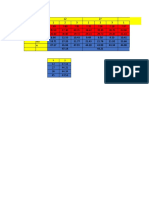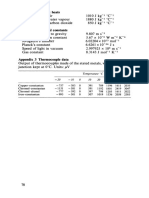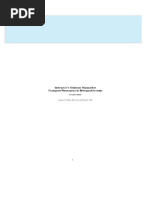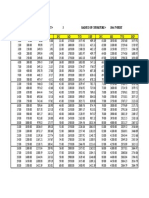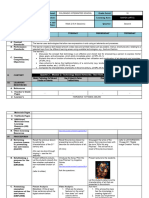Specific Heat and Thermal Expansion of Refractory Nonmetal: Cao
Specific Heat and Thermal Expansion of Refractory Nonmetal: Cao
Uploaded by
azharCopyright:
Available Formats
Specific Heat and Thermal Expansion of Refractory Nonmetal: Cao
Specific Heat and Thermal Expansion of Refractory Nonmetal: Cao
Uploaded by
azharOriginal Title
Copyright
Available Formats
Share this document
Did you find this document useful?
Is this content inappropriate?
Copyright:
Available Formats
Specific Heat and Thermal Expansion of Refractory Nonmetal: Cao
Specific Heat and Thermal Expansion of Refractory Nonmetal: Cao
Uploaded by
azharCopyright:
Available Formats
Open Science Journal of Modern Physics
2015; 2(4): 50-54
Published online July 30, 2015 (http://www.openscienceonline.com/journal/osjmp)
Specific Heat and Thermal Expansion of Refractory
Nonmetal: CaO
Vladimir Yu. Bodryakov*
Institute of Mathematics, Informatics and Information Technologies, Ural State Pedagogical University, Yekaterinburg, Russia
Email address
Bodryakov_VYu@e1.ru
To cite this article
Vladimir Yu. Bodryakov. Specific Heat and Thermal Expansion of Refractory Nonmetal: CaO. Open Science Journal of Modern Physics.
Vol. 2, No. 4, 2015, pp. 50-54.
Abstract
In this paper in the development and dissemination ideas of previously published works on a new class of objects (refractory
nonmetals), a correlation study of molar specific heat C(T), volumetric coefficient of thermal expansion ο(T) and molar volume
V(T) of solid calcium oxide has been made. As for earlier investigated solids, for CaO clear correlation ο(C) takes place not only
at low temperatures, but also to a much wider temperature range. A significant deviation from the linear low-temperature
behaviorο(C) occurs on reaching heat capacity the classical limit 6R by Dulong and Petit law. Temperature dependence is
estimated for calcium oxide of the differential Grüneisen parameter.
Keywords
Calcium Oxide (CaO), Coefficient of Thermal Expansion, Correlation, Differential Grüneisen Parameter, Heat Capacity,
Molar Volume
nonmetals). Namely, the results are presented for solid
1. Introduction calcium oxide (also called lime, quicklime, calcia) of the
correlation study of heat capacity and thermal expansion in the
Alkaline earth metal oxides (AEMO) have numerous whole range of solid state, far beyond the known limits of
technological applications in view of their peculiar physical applicability of low-temperature Grüneisen law. Note an
and chemical properties and high melting points; their essential uncertainty in the melting point Tm of the oxide (K):
behavior at high temperatures and pressures is important from Tm = 3108 [1]; 3200 [2]; 3200 [11]; 2900–50+300 [12]; > 3086
the Geophysics point of view of [1], [2]. Alkaline earth metal [13]; 2903 [14]; 3200 [15]. In this paper accepted value is Tm =
oxides, as well as alkali halides, are also considered as a 3100 K (±100 K). As in [3]–[10], the correlation dependence
convenient model objects, because of their simplest, as is ο(C) is called Grüneisen plot (GP), and according correlation
believed, ionic type of chemical bonding, permitting the analysis – GP-analysis. Cited original sources, without
creating and testing a variety of relatively uncomplicated claiming to be exhaustive list, give quite a clear idea of the
models of their properties. However, a number of important temperature behavior of the properties in question.
physical properties of AEMO insufficiently studied yet; data
of different authors do not agree well with each other. In 2. Results and Discussion
particular, as further seen for CaO, it relates to basic
thermodynamic properties, such as specific heat C(T), Temperature dependence of the molar heat capacity C(T) of
volumetric coefficient of thermal expansion (VCTE) ο(T), solid calcium oxide is shown in Fig. 1. The data [1], [11]–[22]
molar volume V(T), and others. on C(T) (total 13 sets of data, more than 290 points), in general,
Previously published author’s papers [3]–[10] actually reasonably consistent with each other, except for clear
establish a new standard for statistical processing and mutual overestimated data [16]. Data [16] were excluded from the
(correlation) analysis of the fundamental thermodynamic calculation and are just for comparison. It should be
quantities of solids, so here there is no need for a detailed emphasized the urgency for additional modern calorimetric
description of the calculations. The aim of this research is to investigations in the entire temperature range of solid state CaO,
spread the ideas [3]–[10] for a new class of objects (refractory especially at low and high temperatures. These measurements
51 Vladimir Yu. Bodryakov: Specific Heat and Thermal Expansion of Refractory Nonmetal: CaO
should be made on fused and well certified the material. Solid reasonably presents the empirical data on the heat capacity of
(trend) line in Fig. 1 is the result of statistical averaging and calcium oxide. For convenience, the smoothed data C(T), along
smoothing the data C(T) by different authors; the trend with VCTE ο(T) for CaO are given in Table 1.
Table 1. Recommended heat capacity C (JK–1mol–1) and VCTEο (10–6K–1) of solid CaO.
T, K C ο T, K C ο T, K C ο T, K C ο
5 0.0025 0.002 150 26.26 20.17 750 51.47 40.79 1950 56.58 48.47
10 0.020 0.015 160 28.13 21.60 800 51.81 41.24 2000 56.77 48.76
15 0.068 0.051 170 29.83 22.91 850 52.10 41.68 2050 56.96 49.05
20 0.162 0.125 180 31.37 24.09 900 52.37 42.06 2100 57.15 49.34
25 0.316 0.243 190 32.76 25.16 950 52.63 42.49 2150 57.34 49.62
30 0.547 0.42 200 34.03 26.13 1000 52.89 42.87 2200 57.53 49.91
35 0.868 0.67 210 35.17 27.01 1050 53.12 43.22 2250 57.73 50.21
40 1.29 0.99 220 36.20 27.81 1100 53.33 43.54 2300 57.94 50.53
45 1.84 1.42 230 37.14 28.53 1150 53.53 43.86 2350 58.16 50.87
50 2.51 1.92 240 38.03 29.21 1200 53.73 44.15 2400 58.39 51.22
55 3.30 2.53 250 38.84 29.83 1250 53.92 44.44 2450 58.63 51.59
60 4.22 3.24 260 39.58 30.39 1300 54.11 44.73 2500 58.89 51.98
65 5.26 4.03 270 40.27 30.92 1350 54.30 45.01 2550 59.17 52.41
70 6.39 4.91 280 40.92 31.42 1400 54.49 45.30 2600 59.47 52.86
75 7.61 5.84 290 41.52 31.89 1450 54.68 45.59 2650 59.79 53.35
80 8.89 6.83 300 42.15 32.37 1500 54.87 45.88 2700 60.13 53.86
85 10.21 7.84 350 44.87 34.48 1550 55.06 46.16 2750 60.49 54.41
90 11.58 8.89 400 46.72 35.93 1600 55.25 46.45 2800 60.87 54.98
95 12.94 9.94 450 47.97 36.98 1650 55.44 46.74 2850 61.28 55.61
100 14.30 10.99 500 48.94 37.84 1700 55.63 47.03 2900 61.73 56.29
110 16.99 13.05 550 49.63 38.49 1750 55.82 47.32 2950 62.23 57.05
120 19.56 15.02 600 50.22 39.10 1800 56.01 47.61 3000 62.79 57.90
130 21.98 16.88 650 50.71 39.74 1850 56.20 47.89 3050 63.42 58.86
140 24.21 18.59 700 51.12 40.29 1900 56.39 48.19 Tm 64.15 59.97
handbook [24]). There aren’t clear reasons for preferring one set
of data to another, so all of them, including theoretical
estimations, were involved in the computation. Much greater
inconsistency in VCTE compared with heat capacity is
probably due to methodological difficulties in carrying
high-temperature measurements of thermal expansion, and
essentially higher quality requirements to the dilatometric, than
calorimetric, specimens. It is necessary to carry out additional
modern dilatometric studies of well certified fused solid
calcium oxide over the entire temperature range.
Fig. 1. Temperature dependence of molar heat capacity C(T) for solid CaO.
Symbols – tabular data: 1 – [16], 2 – [17], 3 – [18], 4 – [19], 5 – [11], 6 – [12],
7 – [20], 8 – [13], 9 – [14], 10 – [21], 11 – [1], 12 – [15], 13 – [22], 14 (solid
line) – trend.
Temperature dependence of the volumetric coefficient of
thermal expansion of calcium oxide ο(T) is shown in Fig. 2.
Data from [1], [14], [21]–[30] for thermal expansion (a total of
12 sets of data, more than 230 points) are only in
semi-quantitative agreement; dispersion increases coming to
the melting temperature of CaO. Original data of direct Fig. 2. Temperature dependence of volumetric coefficient of thermal expansion
ο(T) for solid CaO. Symbols – tabular data: 1 – [23], 2 – [24], 3 – [25], 4 – [14],
measurements of thermal expansivity of the oxide are very 5 – [21], 6 – [26], 7 – [1], 8 – [27], 9 – [28], 10 – [22], 11 – [29], 12 – [30], 13
scarce and contradictory (see e.g. survey in well-known (solid line) – trend.
Open Science Journal of Modern Physics 2015; 2(4): 50-54 52
change in the character of ο(C) dependence. Above 600 K,
where C> 6R, the slope ο(C) increases and remains
approximately constant up to the melting point Tm= 3100 K.
The temperature of the kink in the dependence ο(C)
approximately accords to Debye temperature of calcium oxide
at this condition: θ(600 K) ∼ 650 K [1], [21]. Estimates [1],
[21] of Debye temperature θ(T) from the elastic constants
show a monotonic decrease θ(T) from ∼ 670 K at T = 300 K
down to ∼ 620 K at T = 1200 K. Calorimetric estimates [18]
indicate more complex temperature behavior and somewhat
smaller values θ(T):θ(300 K) ∼ 570 K.
Fig. 3. GP-diagram – correlation dependence ο(C) for CaO. Symbols –
averaged and smoothed data of VCTE and molar heat capacity; straight line
– linear regression οlin(C) for low-temperature values ο(C). Arrow indicates
classical limit 6R by Dulong and Petit for heat capacity.
Fig. 5. Temperature dependence of molar volume V(T) for solid CaO: 1 –
[31], 2 – [23], 3 – [32], 4 – [33], 5 – [34], 6 – [35], 7 – [36], 8 – [24], 9 – [21],
10 – [1], 11 – [29], 12 – [37], 13 – [30], 14 (solid line) – trend.
Fig. 4. The same as Fig. 3 for difference ∆ο(C)for CaO.
Accuracy of smoothed values C(T) and ο(T) in Fig. 1, 2 can
be estimated visually – by an extent to which the trend lines
accord to empirical data [1, 2, 11-30], and quantitatively – by
standard deviation (SD) of empirical points from the trends
C(T), ο(T) at each temperature point.
GP – correlation dependence ο(C), where averaged and
smoothed values of molar heat capacity and volumetric Fig. 6. Temperature dependence of differential Grüneisen parameter γ′(T) for
thermal expansivity of CaO are taken in the according solid CaO. Dashed line – a piecewise linear approximation.
temperature points, – is shown in Fig. 3. In the temperature
range 0 <T≤ 500 K, for which the specific heat 0 <C≤ 48.94 J As clearly seen from the difference GP-diagram (Fig. 4)
K-1 mol-1, and VCTE 0 <ο≤ 37.84×10-6 K-1, the dependence
ο(C) is linear with the high level of correlation (R2 = 0.999997, ∆ο(C) = ο(C) – οlin(C), (2)
n = 47 points): points ο(C) well above CDP fit well with smooth growing
οlin(C)=(0.7684±0.0002)×С, (1) dependence close to the straight line. Shown in Fig. 3, 4, the
results can be interpreted as almost strict constancy below ∼
where in VCTE is in units 10-6 K-1, and the heat capacity is in 600 K of differential Grüneisen parameter:
the J K-1 mol-1. SD of ο(C) points out of the regression straight
line (1) is of small value σ≈0.040×10-6 K-1. In achieving heat γ′ = V0K0(∂ο/∂C), (3)
capacity the classical limit by Dulong and Petit CDP = 6R≈ where’s accepted: V0 = 16.71 ± 0.02 cm3 mol-1 and K0 = 112 ±
49.88 J K-1 mol-1 for CaO, there is a drastic, close to the kink, 2 GPa – low-temperature limits of the molar volume and bulk
53 Vladimir Yu. Bodryakov: Specific Heat and Thermal Expansion of Refractory Nonmetal: CaO
modulus for CaO. The value K0 is estimated based on the V(T) = V0exp ο . (4)
values of the elastic constants [21]. The value V0 is obtained
from dilatometric data [1], [21], [23], [24], [29]–[37] (13 sets The comparison of molar volume V(T) computed using Eq.
of data, about 230 points). Additional checking molar volume (4) with the dilatometric data [1], [21], [23], [24], [29]–[37]
of CaO was necessary because of the valuable dispersion of (Fig. 5) confirms its quantitative adequacy and therefore
thermal expansion data by various authors. For this, the trend established trend ο(T). For convenience, the smoothed
dependence ο(T) was numerically integrated and temperature temperature dependences of molar volume V(T) and density ρ
dependence of molar volume was get: = µ/V, where µis the molar mass of CaO, are given in Table 2.
Table 2. Recommended molar volume V (cm3mol–1) and densityρ (kgm–3) of solid CaO.
T, K V ρ T, K V ρ T, K V ρ T, K V ρ
5 16.71 ± 0.02 3356 ± 4 500 16.92 3315 1400 17.57 3191 2300 18.35 3057
50 16.71 3356 600 16.98 3302 1500 17.65 3177 2400 18.44 3041
100 16.72 3355 700 17.05 3289 1600 17.74 3162 2500 18.54 3025
150 16.73 3352 800 17.12 3275 1700 17.82 3147 2600 18.63 3010
200 16.75 3348 900 17.19 3262 1800 17.90 3132 2700 18.73 2994
250 16.77 3344 1000 17.27 3248 1900 17.99 3117 2800 18.84 2977
300 16.80 3338 1100 17.34 3234 2000 18.08 3102 2900 18.94 2961
350 16.83 3333 1200 17.42 3220 2100 18.16 3087 3000 19.05 2944
400 16.86 3327 1300 17.49 3206 2200 18.26 3072 Tm 19.16 2927
Above ∼ 800 K (beyond the transition area) differential
Grüneisen parameter γ′ is close to a greater also constant value Acknowledgements
(Fig. 6). To find the parameter γ′ with use of Eq. (3) digital
differentiation of correlation GP-dependence ο(C) was The author is grateful to Mrs. Irina V. Ivanova (USPU,
applied (without further smoothing). Piecewise-linear Yekaterinburg) for assistance in providing sources of original
approximation is shown in Fig. 6 by dashed line. Increased thermodynamic data.
dispersion of the points γ′(T) is due to a procedure of
numerical differentiation. References
Unusual behavior of differential Grüneisen parameter γ′(T)
of calcium oxide is contrary to traditional views about the [1] O. L. Anderson. Equations of State of Solids for Geophysics
behavior of Grüneisen parameter γ(T) in solids, including and Ceramic Sciences / Oxford Monographs on Geology and
Geophysics No. 31. New York – Oxford: Oxford University
AEMO (see, e.g., [1, 21, 25]). Clearly observed kink in the Press, 1995. – 405 p.
dependence γ′(T) at ∼ 600 K for CaO, as well as for other
studied solids [3]–[10], cannot be explained by the [2] W. Martienssen and H. Warlimont. Springer Handbook of
contribution of thermal vacancies; the latter could have a Condenced Matter and Materials Data. Berlin – Heidelberg –
NewYork: Springer, 2005, 1121 p.
significant effect higher than ∼ 0,7Tm∼ 2100 K. Therefore, the
observed above 600 K feature in the behavior of correlation [3] V. Yu. Bodryakov. Correlation of Temperature Dependencies of
dependence ο(C) allows to assume “turning on” new, needed Thermal Expansion and Heat Capacity of Refractory Metal up to
the Melting Point: Molybdenum. High Temperature. 2014; 52
additional study, mechanisms of formation of thermodynamic
(6): 840–845.
properties of solid calcium oxide.
[4] V. Yu. Bodryakov. On the Correlation between Thermal
Expansion Coefficient and Heat Capacity of Argon Cryocrystals.
3. Conclusion Physics of the Solid State. 2014; 56(11): 2359–2365.
The GP-analysis formed in the example of solid calcium [5] V. Yu. Bodryakov. Correlation of Coefficient of Thermal
oxide shows, contrary to traditional views, a significant Expansion and Heat Capacity of Noble Gas Cryocrystal: Kripton.
change in a mechanism of formation of the temperature Technical Physics. 2015; 60 (3):381-384.
dependences ο(T) and/or heat capacity C(T) above T≈ 600 K [6] V. Yu. Bodryakov. Correlation between the Thermal Expansion
∼θ(T), i.e. upon reaching by heat capacity the classical limit Coefficient and Heat Capacity of Solid Xenon. Inorganic
CDP = 6R. This problem, however, requires a focused Materials. 2015; 51(2): 172–176.
theoretical investigations; satisfactory microscopic model for [7] V. Yu. Bodryakov. On Correlation between Heat Capacity and
the interpretation of the above results, is absent now. It should Thermal Expansivity of Cubic Pt-Metals (Following to the John
be noted that in the present study for constructing the Arblaster’s Evaluations). Open Sci. J. Mod. Phys. 2015; 2(1):
smoothed trend lines C(T) and ο(T) no model of the 10–13.
thermodynamic properties has been used; it is to emphasize [8] V. Yu.Bodryakov and A. A. Bykov. Correlation Characteristics
the objective, out-model nature of the main results. of Thermal Expansion Volume Coefficient and Thermal
Capacity in Corundum.Glass and Ceramics. 2015;72 (1-2):
67–70.
Open Science Journal of Modern Physics 2015; 2(4): 50-54 54
[9] V. Yu. Bodryakov and Yu. N. Babintsev. Correlation Analysis [22] Landolt-Börnstein - Group III Condensed Matter. Numerical
of the Heat Capacity and Thermal Expansionof Solid Mercury. Data and Functional Relationships in Science and Technology.
Phys. Solid State. 2015; 57(6): 1264–1269. V. 41B. Calcium oxide (CaO) Debye temperature, heat capacity,
density, melting and boiling points, hardness. Berlin –
[10] V. Yu. Bodryakov.Correlation of Temperature Dependencies of Heidelberg: Springer, 1999.
Thermal Expansion and Heat Capacity of Refractory Metal up
to the Melting Point: Tungsten. High Temperature. 2015; 53(5). [23] R. J. Beals and R. L. Cook. Directional Dilatation of Crystal
Lattices at Elevated Temperatures. J. Amer. Ceram. Soc. 1957;
[11] R. A. Robie, B. S. Hemingway, and J. R. Fisher. 40(8): 279–284.
Thermodynamic properties of minerals and related substances
at 298,15 K (25 °C) and one atmosphere (1,013 Bars) pressure [24] Y.S. Touloukian, R.K. Kirby, R.E. Taylor, and T.Y.R. Lee.
and at higher temperatures./ Geological survey bulletin. Thermphysical Properties of Matter – The TPRC Data Series. V.
Washington: US Government printing office. 1979. N.1452. 13. Thermal expansion – Nonmetallic Solids. NY–Washington:
456 p. IFI/Plenum, 1977.
[12] L.V. Gurvich,V. I. Veits, V. A. Medvedev, V. A. Krachkuruzov, [25] R. Ruppin. Grüneisen Parameters and Thermal Expansion of
V. S. Yungman, V. A. Bergman, V.F. Baibuz, V. S. Iorish, V. N. CaO and SrO. Solid State Comm. 1972; 10(11): 1053–1056.
Yurkov, S. I. Gorbov, I. I. Nazarenko, O. V. Dorofeeva,V. F.
Kuratova, E. L. Osina, A. V. Gusarov, V. Ya. Leonidov, I. N. [26] S. K.Saxena and G.Shen. Assessed Data on Heat Capacity,
Przheval’skii, A. L. Rogatskii, Yu. M. Efremov, V. G. Ryabova, Thermal Expansion and Compressibility for Some Oxides and
V. Yu. Zitserman, Yu. G. Hait, E. A. Shenyavskaya, M. E. Silicates. J. Geophys. Res. 1992; 97(B13): 19813–19825.
Efimov, V. A. Kulemza, Yu. S. Khodeev, S. E. Tomberg, V. N.
Vdovin, A. Ya. Yakobson, and M. S. Demidova. [27] S. P. Upadhyay and M. Kumar. Thermal Expansion and
Termodinamicheskie Svoistva Individual’nykh Veshchestv. Compression of Alkaline Earth Oxides and Cesium Halides at
Spravochnoe izdanie v 4-kh tomakh (Thermodynamic High Temperature and High Pressure. Phys. Stat. Sol. (b). 1995;
Properties of Individual Substances: A Reference Book in Four 191(2): 299–305.
Volumes), Glushko V.P., Ed., vol. III, books 1–2, Moscow: [28] N. A. Dubrovinskaya, L. S. Dubrovinsky, and S. K. Saxena.
Nauka, 1981. Systematics of Thermodynamic Data on Solids:
[13] V.Ya. Chekhovskoy, Kh. Irgashov, and V. D. Tarasov. Thermochemical and Pressure-Volume-Temperature Properties
Eksperimental’noeIssledovanieEntal’piiiTeploemkostiOksida of Some Minerals. Geochim. Cosmochim. Acta. 1997; 61(19):
Kal’tsiadoTemperatury 3100 K (EksperimentalStudy of 4151–4158.
Enthalpy and Heat Capacity of Calcium Oxide upto the [29] G. Fiquet, P. Richet, and G. Montagnac. High-Temperature
Temperature 3100 K).High Temperature. 1986; 24(3): Thermal Expansion of Lime, Periclase, Corundum and Spinel //
614–617. Phys. Chem. Minerals. 1999; 27(2): 103–111.
[14] Handbook of Physical Quantities, Grigoriev I.S. and Meilikhov [30] A. S. M. Rao and K. Narender. Studies on Thermophysical
E.Z., Eds., Boca Raton, Florida, United States: CRC Press, Properties of CaO and MgO by γ-Ray Attenuation. J.
1996. Thermodyn. 2014; 2014 (ID 123478): 1–8.
[15] M.W. Chase. NIST-JANAF Thermochemical Tables. J. Phys. [31] O.J.Whittemore and N.N.Ault. Thermal Expansion of Various
Chem. Ref. Data. 1998; Monograph 9: 1-1951. (URL: Ceramic Materials to 1500 °C. J. Amer. Ceram. Soc. 1956;
http://kinetics.nist.gov/janaf/html/Ca-029.html). 39(12): 443–444.
[16] Lander J. J. Experimental Heat Contents of SrO, BaO, CaO, [32] C.F. Grain and W.J. Campbell Thermal Expansion and Phase
BaCO3 and SrCO3 at High Temperatures. Dissociation Inversion of Six Refractory Oxides / U.S. Bur. Mines Rept.
Pressures of BaCO3 and SrCO3. J. Amer. Chem. Soc. 1951; BM-RI-5982, 1962.
73(12): 5794–5797.
[33] T.Nielsen and M.Leipold. Thermal Expansion in Air of
[17] K.K. Kelley. Contributions to the Data on Theoretical Ceramic Oxides to 2200°C / Jet Propulsion Lab. Rept.
Metallurgy. XIII. High Temperature Heat Content, Heat JPL-TR-32-297, 1962.
Capacity and Entropy Data for the Elements and Inorganic
Compounds, Washigton: US Government printing office, 1960. [34] H.Ohba, K.Hiragushi, and C.Nakashima. High Temperature
Properties of Dolomite: I. Study of Dolomite Refractories by
[18] E. Gmelin. Thermal Properties of Alcaline-Earth-Oxides. I. High Temperature X-ray Diffraction. Taikabutsu. 1965; 17(94):
Specific heat measurements. Z. Naturforsch. 1969; 24a(11): 364–371.
1794–1800.
[35] D.K.Smith and H. R. Leider Low-Temperature Thermal
[19] Y.S.Touloukian and C.Y. Ho. Thermophysical properties of Expansion of Lithium Hydride, Magnesium Oxide, and
matter. The TPRC Data Series. V. 5. Specific Heat – Calcium Oxide. J. Appl. Crystallogr. 1968; 1(4): 246–249.
Nonmetallic Solids. NY–Washington: IFI/Plenum, 1970.
[36] O.Kamada, T.Takizawa, and T.Sakurai. A High Temperature
[20] Kh. Irgashov, V. D. Tarasov, and V. Ya. Chekhovskoy. Ental’pia X-Ray Diffractometer Using a Solar Furnace // Jap. J. Appl.
i Teploemkost’ CaO v Intervale Temperatur 1220–2550 K Phys. 1971; 10(4): 485–490.
(Enthalpy and heat Capacity of CaO in the temperature range
1220–2550 K. High Temperature. 1984; 22(1): 59–63. [37] A. Vijay. Temperature Dependence of Elastic Constants and
Volume Expansion for Cubic and Non-cubic Minerals. Physica
[21] H. Oda, O. L. Anderson, D. G. Isaak, and I. Suzuki. B. 2004; 349(1–4): 62–70.
Measurement of Elastic Properties of Single-Crystal CaO up to
1200 K. Phys. Chem. Minerals. 1992; 19(2): 96-105.
You might also like
- Appendix A Thermochemical Data and Conversion Factors 2015 CombustionNo ratings yetAppendix A Thermochemical Data and Conversion Factors 2015 Combustion112 pages
- Thermodynamic Properties of Polyethylene: R. M. C. PetreeNo ratings yetThermodynamic Properties of Polyethylene: R. M. C. Petree10 pages
- Meng V - Civ. Eng. 17TP21337: Fankam Noukimi CabrelNo ratings yetMeng V - Civ. Eng. 17TP21337: Fankam Noukimi Cabrel1 page
- Treated (ML) Residual Chromium Concentra Tion (Ce) (MG/L) Chromium Uptake (Co-Ce) (MG/L) % Removal of Chromium ( (Co-Ce) /co) 100No ratings yetTreated (ML) Residual Chromium Concentra Tion (Ce) (MG/L) Chromium Uptake (Co-Ce) (MG/L) % Removal of Chromium ( (Co-Ce) /co) 10014 pages
- Technical Data For Propane, Butane, and LPG Mixtures: Alternate Energy Systems, IncNo ratings yetTechnical Data For Propane, Butane, and LPG Mixtures: Alternate Energy Systems, Inc4 pages
- C (Kpa) 60 F 30 Depth of The Pile (M) 20 Dia of The Pile (M) 0.5 D/B 40 A 0.45 0.7 F/D 0.6 Fos (Skin) 2.5 Fos (Base) 2.5 KS/KNo ratings yetC (Kpa) 60 F 30 Depth of The Pile (M) 20 Dia of The Pile (M) 0.5 D/B 40 A 0.45 0.7 F/D 0.6 Fos (Skin) 2.5 Fos (Base) 2.5 KS/K6 pages
- As Per DW/143, EN 1886: 1998, EN 1751:1999 Standard As Per SMACNA StandardNo ratings yetAs Per DW/143, EN 1886: 1998, EN 1751:1999 Standard As Per SMACNA Standard6 pages
- Instant download Instructor s Solutions Manual for Transport Phenomena in Biological Systems 2nd Edition George A. Truskey pdf all chapter100% (5)Instant download Instructor s Solutions Manual for Transport Phenomena in Biological Systems 2nd Edition George A. Truskey pdf all chapter75 pages
- A.5 Critical Values of the χ Distribution: 2 k,q 2 2 k 2 k,q 2 k 2 k,q 2No ratings yetA.5 Critical Values of the χ Distribution: 2 k,q 2 2 k 2 k,q 2 k 2 k,q 22 pages
- Data Table 1: Readings For BJT AmplifierNo ratings yetData Table 1: Readings For BJT Amplifier2 pages
- Table C. Critical Values of Chi-Square Distribu: Si Ificance - 10 - . 1 - . - 1No ratings yetTable C. Critical Values of Chi-Square Distribu: Si Ificance - 10 - . 1 - . - 11 page
- Build Rate Deg/100 Feet 2 Radius of Curvature 2864.79 FEETNo ratings yetBuild Rate Deg/100 Feet 2 Radius of Curvature 2864.79 FEET1 page
- ANSI-ASME B16.47 Series B Weld Neck Flange 150lb100% (1)ANSI-ASME B16.47 Series B Weld Neck Flange 150lb1 page
- Data Set 13b: New Feed To Cyclone BM CCT Feed Cyclone Feed Cyclone U/f BM Discharge Cyclone O/fNo ratings yetData Set 13b: New Feed To Cyclone BM CCT Feed Cyclone Feed Cyclone U/f BM Discharge Cyclone O/f4 pages
- Approximate Generator Fuel Consumption Chart100% (1)Approximate Generator Fuel Consumption Chart1 page
- Steam Table (Metric Units) For Saturated Condition PropertiesNo ratings yetSteam Table (Metric Units) For Saturated Condition Properties4 pages
- Progress in Inorganic ChemistryFrom EverandProgress in Inorganic ChemistryKenneth D. KarlinNo ratings yet
- College of Arts and Sciences Psychology Department 1 Semester, SY 2020-2021100% (3)College of Arts and Sciences Psychology Department 1 Semester, SY 2020-20212 pages
- 3.3 Graphs - Finding Regions Easy Question Paper 1 Edexcel A Level Pure Maths - 2No ratings yet3.3 Graphs - Finding Regions Easy Question Paper 1 Edexcel A Level Pure Maths - 28 pages
- Bas-Svp023f-En - 07182022 - Tabla ModbusNo ratings yetBas-Svp023f-En - 07182022 - Tabla Modbus28 pages
- Risk Perception and Risk Communication With Regard To Nanomaterials in The WorkplaceNo ratings yetRisk Perception and Risk Communication With Regard To Nanomaterials in The Workplace118 pages
- 10 - Imperfection in Solids Point Defects in MetalsNo ratings yet10 - Imperfection in Solids Point Defects in Metals12 pages
- 15 QUESTIONSfor UPCATReviewer Sept 29 For Printingor Collating 28 Final 2928029No ratings yet15 QUESTIONSfor UPCATReviewer Sept 29 For Printingor Collating 28 Final 29280295 pages
- 2023 - 11th Research Symposium Abstract BookletNo ratings yet2023 - 11th Research Symposium Abstract Booklet80 pages
- Science Presentation of Data of The ExperimentNo ratings yetScience Presentation of Data of The Experiment29 pages
- Process OF Hospitalization MCQ FON BY NADEEM KHAN50% (2)Process OF Hospitalization MCQ FON BY NADEEM KHAN13 pages
- Pioneer djm-900srt rrv4491 Dj-Mixer PDFNo ratings yetPioneer djm-900srt rrv4491 Dj-Mixer PDF118 pages
- (M8Ge-Ive-1) : Learning Activity 1: Can You See Me?100% (1)(M8Ge-Ive-1) : Learning Activity 1: Can You See Me?4 pages
- Example: Problem With: The Brochure Sample : Appeal Be Consider Depend Feel Have Look See Smell ThinkNo ratings yetExample: Problem With: The Brochure Sample : Appeal Be Consider Depend Feel Have Look See Smell Think5 pages
- Ivanova 2014 Consequences of Anabolic Steroids AbuseNo ratings yetIvanova 2014 Consequences of Anabolic Steroids Abuse8 pages
- Get Lawrie's Meat Science, 8th Ed 8th Edition Fidel Toldra Free All Chapters100% (2)Get Lawrie's Meat Science, 8th Ed 8th Edition Fidel Toldra Free All Chapters49 pages
- Appendix A Thermochemical Data and Conversion Factors 2015 CombustionAppendix A Thermochemical Data and Conversion Factors 2015 Combustion
- Thermodynamic Properties of Polyethylene: R. M. C. PetreeThermodynamic Properties of Polyethylene: R. M. C. Petree
- Meng V - Civ. Eng. 17TP21337: Fankam Noukimi CabrelMeng V - Civ. Eng. 17TP21337: Fankam Noukimi Cabrel
- Treated (ML) Residual Chromium Concentra Tion (Ce) (MG/L) Chromium Uptake (Co-Ce) (MG/L) % Removal of Chromium ( (Co-Ce) /co) 100Treated (ML) Residual Chromium Concentra Tion (Ce) (MG/L) Chromium Uptake (Co-Ce) (MG/L) % Removal of Chromium ( (Co-Ce) /co) 100
- Technical Data For Propane, Butane, and LPG Mixtures: Alternate Energy Systems, IncTechnical Data For Propane, Butane, and LPG Mixtures: Alternate Energy Systems, Inc
- C (Kpa) 60 F 30 Depth of The Pile (M) 20 Dia of The Pile (M) 0.5 D/B 40 A 0.45 0.7 F/D 0.6 Fos (Skin) 2.5 Fos (Base) 2.5 KS/KC (Kpa) 60 F 30 Depth of The Pile (M) 20 Dia of The Pile (M) 0.5 D/B 40 A 0.45 0.7 F/D 0.6 Fos (Skin) 2.5 Fos (Base) 2.5 KS/K
- As Per DW/143, EN 1886: 1998, EN 1751:1999 Standard As Per SMACNA StandardAs Per DW/143, EN 1886: 1998, EN 1751:1999 Standard As Per SMACNA Standard
- Instant download Instructor s Solutions Manual for Transport Phenomena in Biological Systems 2nd Edition George A. Truskey pdf all chapterInstant download Instructor s Solutions Manual for Transport Phenomena in Biological Systems 2nd Edition George A. Truskey pdf all chapter
- A.5 Critical Values of the χ Distribution: 2 k,q 2 2 k 2 k,q 2 k 2 k,q 2A.5 Critical Values of the χ Distribution: 2 k,q 2 2 k 2 k,q 2 k 2 k,q 2
- Table C. Critical Values of Chi-Square Distribu: Si Ificance - 10 - . 1 - . - 1Table C. Critical Values of Chi-Square Distribu: Si Ificance - 10 - . 1 - . - 1
- Build Rate Deg/100 Feet 2 Radius of Curvature 2864.79 FEETBuild Rate Deg/100 Feet 2 Radius of Curvature 2864.79 FEET
- Data Set 13b: New Feed To Cyclone BM CCT Feed Cyclone Feed Cyclone U/f BM Discharge Cyclone O/fData Set 13b: New Feed To Cyclone BM CCT Feed Cyclone Feed Cyclone U/f BM Discharge Cyclone O/f
- Steam Table (Metric Units) For Saturated Condition PropertiesSteam Table (Metric Units) For Saturated Condition Properties
- College of Arts and Sciences Psychology Department 1 Semester, SY 2020-2021College of Arts and Sciences Psychology Department 1 Semester, SY 2020-2021
- 3.3 Graphs - Finding Regions Easy Question Paper 1 Edexcel A Level Pure Maths - 23.3 Graphs - Finding Regions Easy Question Paper 1 Edexcel A Level Pure Maths - 2
- Risk Perception and Risk Communication With Regard To Nanomaterials in The WorkplaceRisk Perception and Risk Communication With Regard To Nanomaterials in The Workplace
- 10 - Imperfection in Solids Point Defects in Metals10 - Imperfection in Solids Point Defects in Metals
- 15 QUESTIONSfor UPCATReviewer Sept 29 For Printingor Collating 28 Final 292802915 QUESTIONSfor UPCATReviewer Sept 29 For Printingor Collating 28 Final 2928029
- (M8Ge-Ive-1) : Learning Activity 1: Can You See Me?(M8Ge-Ive-1) : Learning Activity 1: Can You See Me?
- Example: Problem With: The Brochure Sample : Appeal Be Consider Depend Feel Have Look See Smell ThinkExample: Problem With: The Brochure Sample : Appeal Be Consider Depend Feel Have Look See Smell Think
- Ivanova 2014 Consequences of Anabolic Steroids AbuseIvanova 2014 Consequences of Anabolic Steroids Abuse
- Get Lawrie's Meat Science, 8th Ed 8th Edition Fidel Toldra Free All ChaptersGet Lawrie's Meat Science, 8th Ed 8th Edition Fidel Toldra Free All Chapters









